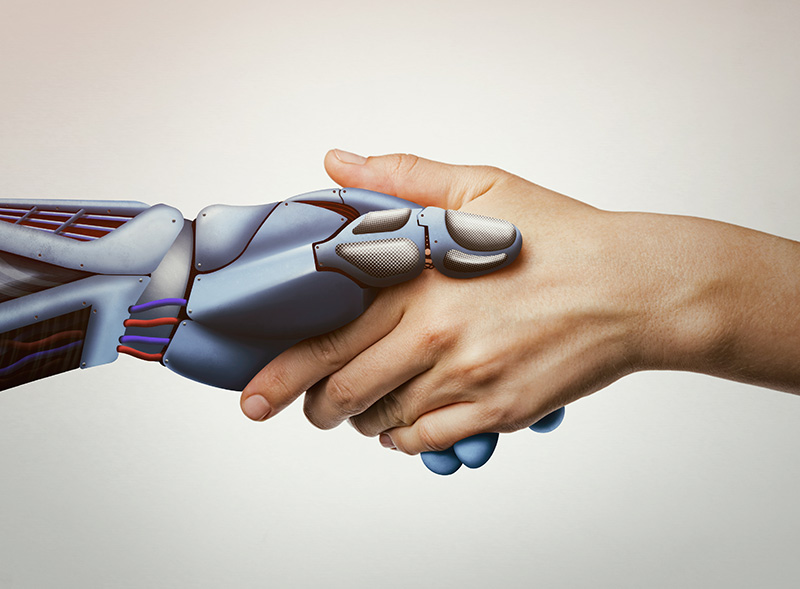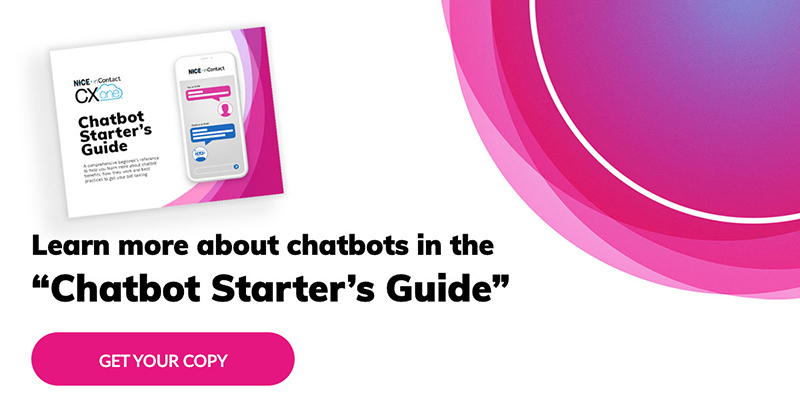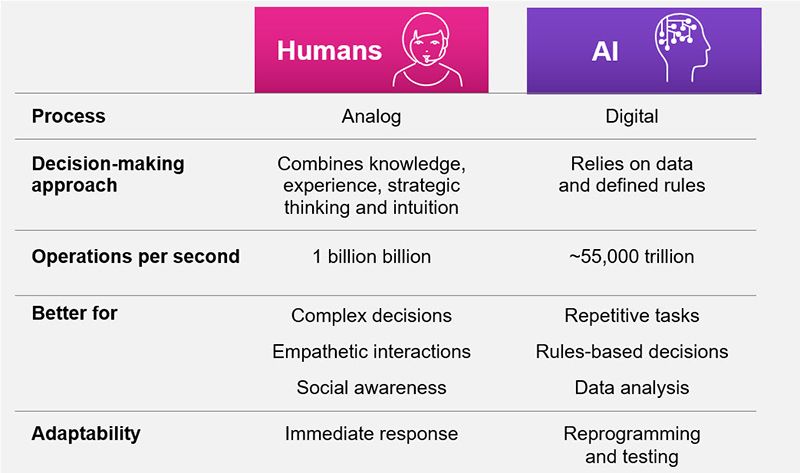Say the words “Artificial Intelligence” in a contact center and you’ll likely see a lot of concerned faces.
Why? It’s simple. They’re concerned that AI will replace them. Take away their jobs. Make them redundant.
While those concerns are valid, they are underestimating the unique and irreplaceable value that people—agents and supervisors—deliver. A value that AI can never replace.
What’s the difference between the way humans think and AI works?
So, let’s start by understanding the differences between humans and AI.
Artificial Intelligence (AI): It seems everyone has a different definition for AI. Here’s my favorite: “a branch of computer science that aims to imbue software with the ability to analyze its environment using either predetermined rules and search algorithms, or pattern recognizing machine learning models, and then make decisions based on those analyses.”1
Human intelligence, on the other hand, is defined as the “mental quality that consists of the abilities to learn from experience, adapt to new situations, understand and handle abstract concepts, and use knowledge to manipulate one’s environment.”2
Based on those definitions, you can see that humans and AI are better suited for different tasks.
- Humans are great at using their experience and knowledge to problem solve and develop strategies. While AI is perfect for rules-based tasks and analyzing lots of data.
- Humans are better at dealing with situations that require strategic thinking, social awareness and empathy. On the other hand, AI is ideal for analyzing large amounts of data, applying defined rules, and managing repetitive tasks.
- How quickly we operate varies as well. Despite the incredible advancements in computer processing, the world’s fastest computer still isn’t as fast as our brains!
- Humans are also much quicker to adapt when faced with new or uncertain situations, whereas AI usually requires reprogramming to adapt to unknown events.
Operations per second definition
AI will never replace contact center agents and supervisors
This may be a bold statement but let me explain.
For contact centers, AI is a great tool to handle specific agent tasks, but it can never replace everything an agent or supervisor does.
For example, AI is super-efficient at handling repetitive tasks and analyzing lots of data—two things you have a lot of in a contact center. And while you can use humans to perform these tasks, that approach will be very time-consuming and costly. It can also lead to agents and supervisors spending the majority of their time dealing with boring work, which may lead to job dissatisfaction and turnover.
On the other hand, AI isn’t a great tool to reassure upset customers or figuring out a novel approach to solving an issue. When a customer is frustrated, hearing a disembodied robotic voice isn’t what they want. They want a human being who can empathize with their situation and understand their concerns.
So, while AI might take over some tasks your agents and supervisors currently manage, it can’t do their entire job. You can reassure your agents and supervisors that they don’t need to lose any sleep over using AI.
Now, let’s look at some specific tasks are better suited for humans and where AI can help.
Six contact center tasks where AI can help

Rather than fearing AI, agents and supervisors need to see the value it can bring to them. How it can help make their jobs easier. Free them from hours and hours of performing the same task repeatedly. Giving them opportunities to expand their skillsets by handling more challenging activities and drive strategic business improvements.
Here are six tasks where AI is a huge benefit to agents and supervisors.
1. Getting customers to help themselves: Adding conversational AI to power your IVR and chatbots to handle routine interactions like order status, account balances, etc. is a great use of AI. By enabling customers to speak or write naturally, you’ll not only make it easier for customers to help themselves, they’ll also likely never need to speak to a live agent at all. Your customers are happy because they get quick answers, and your agents are happy because they have more time to focus on higher value interactions that require a personal touch.
2. Collecting basic information: Using IVR and chatbots to gather basic information like the customer’s name and account information is a great example of AI-agent teamwork. Rather than having the customer wait in a queue for a live agent, AI can gather the customer’s information. Then when the agent is ready to take over the interaction, all that information seamlessly transfers over to the agent. The agent is happy because they already have the basic information available and the customer is happy because they’ve gotten fast service. It’s a win-win.
3. Verifying customers identity: AI is also great at verifying a customer’s identity. So, rather than have an agent spend several minutes confirming the customer’s name, phone number, email, account number, and other data, AI can do it simply with a voice print. Voice biometrics can verify a customer merely by having them speak. Here AI can shave minutes off an interaction, reducing the handle time and per-interaction costs.
4. Analyzing customer sentiment: AI is designed to analyze massive amounts of data. And in a contact center, you gather a ton of data with each interaction. You collect customer data, call flow details, agent notes, etc. But, you can also analyze the customer’s emotion, also known as their sentiment. You can track when they are frustrated, happy or upset. And supervisors can use AI to identify which agents might need additional training to improve their capabilities. Or which agents are experts at turning upset customers to happy ones so they could coach their peers. It can also pinpoint which products or processes need to be improved to avoid customer frustration. Analyzing all this data manually would take countless hours and people. Why not let AI help instead?
5. Scheduling and forecasting: AI is a perfect fit to help supervisors with their scheduling and forecasting Manually creating schedules in spreadsheets can be a time-consuming and error-prone task for supervisors. Adding AI can automate schedule creation, easily handle inevitable adjustments and improve the accuracy of staffing forecast. Using AI-powered workforce management tools, supervisors can reduce labor waste with accurate forecasts. They can maximize headcount utilization with schedules that ensure agents are in the right place at the right time. And they can improve omnichannel customer experience by having the right-skilled agents staffed across all supported channels.
6. Agent Guidance: It’s impossible for a supervisor to monitor every call in real-time, let alone provide in-the-moment advice to every agent. That’s where AI can help. AI can monitor the agent behaviors that impact customer sentiment and guide agents on the most impactful soft skills that influence customer satisfaction. Best of all, it can provide this guidance to every agent, on every call, in real-time! Using AI here helps the agents immediately adjust their behaviors, boosts customer satisfaction, and complements the work of your human supervisors.
Five contact center tasks that only humans can manage

1. Managing upset customers: I think it’s safe to say we’ve all had at least one frustrating customer service experience. Maybe you’ve had an unexpected charge on your account. Or maybe the new product you purchased isn’t working properly. How empathetic an agent is and how skillfully they manage the interaction can make or break the customer relationship. When a customer is upset, they don’t want a bot or recorded message. They want an empathetic agent to listen to them vent and reassure them that their issue will be resolved satisfactorily. Where AI can play a role is in gauging empathetic an agent is being towards the customer and provide guidance on how they can improve their behaviors.
2. Creative solution solving: When a customer is upset and threatens to never do business with you again, saving that customer relationship takes some creative approaches. AI isn’t suited for creativity—humans are. Agents can quickly combine a variety of sources to come up with a solution. They can recall how they handled similar interactions, add in their own personal experiences when an issue was resolved for them, factor in their training and knowledge, etc. They can quickly pull that information together to figure out how best to address the customer’s specific issue.
3. Inspiring and motivating teams: When employees need inspiration, support or recognition, they don’t look to AI. They’ll look for a person. A supervisor’s enthusiasm for a new process change can win over skeptical staff. Their excitement over a new employee rewards initiative can improve participation. Their candor and leadership can instill a sense of unity that pulls everyone together to accomplish the goal. AI just doesn’t have any of the capabilities it takes to deliver these results.
4. Ambiguous situations: AI is great at analyzing data to identify trends and likely outcomes. But it’s not so adept at handling a brand-new situation that it’s never encountered before since it has no reference point in its dataset to determine what to do next. Humans on the other hand can pull from a variety of resources and experiences to figure out what to do in an unknown situation. Just think how quickly everyone in your contact center had to adjust to all the changes we had to deal with when the global pandemic hit. Only humans have that kind of quick adaptability and agility.
5. Collaboration: Human interaction essential to true collaboration. Sure, AI can analyze data and reveal insights, but you can’t have a conversation with it to solve problems. It can’t tell you how it solved an issue before. When an agent encounters a particularly difficult customer, being able to collaborate with others is crucial to solving the customer’s issue. They can ask another agent for advice. They ask their supervisor for support or guidance. Or they can engage a subject-matter expert who works outside of the contact center. Collaboration is the key. And the key to collaboration is humans.
An easy way to infuse AI throughout your contact center
By now, I hope I’ve shown you the benefits integrating AI in your contact center to complement your agents and supervisors, not replace them. What you’ll end up with is happier customers, more productive staff, and better business outcomes.
But where do you start?
NICE CXone infuses AI across all areas of the platform—from chatbots and conversational AI, to scheduling and forecasting, sentiment analysis and real-time agent guidance, just to name a few.
By comparing the differences between AI and humans, I hope you can see how AI will never replace human agents in the contact center. And next time your agents and supervisors hear the team “AI,” they’ll be excited about how it will improve their jobs, not take them away.
If you’re looking to take the next step with technology implementation, check out our latest eBook, “The Chatbot Starter’s Guide.” This resource gives an introduction to AI and chatbots while also walking you through ways to implement it in your contact center.

Secondary Asset: Chatbot Starter's Guide
Secondary Asset: Tips for Building the Best Chatbot eBook
Secondary Asset: NICE CXone with Artificial Intelligence (AI) Self-Service Bots and IVR





